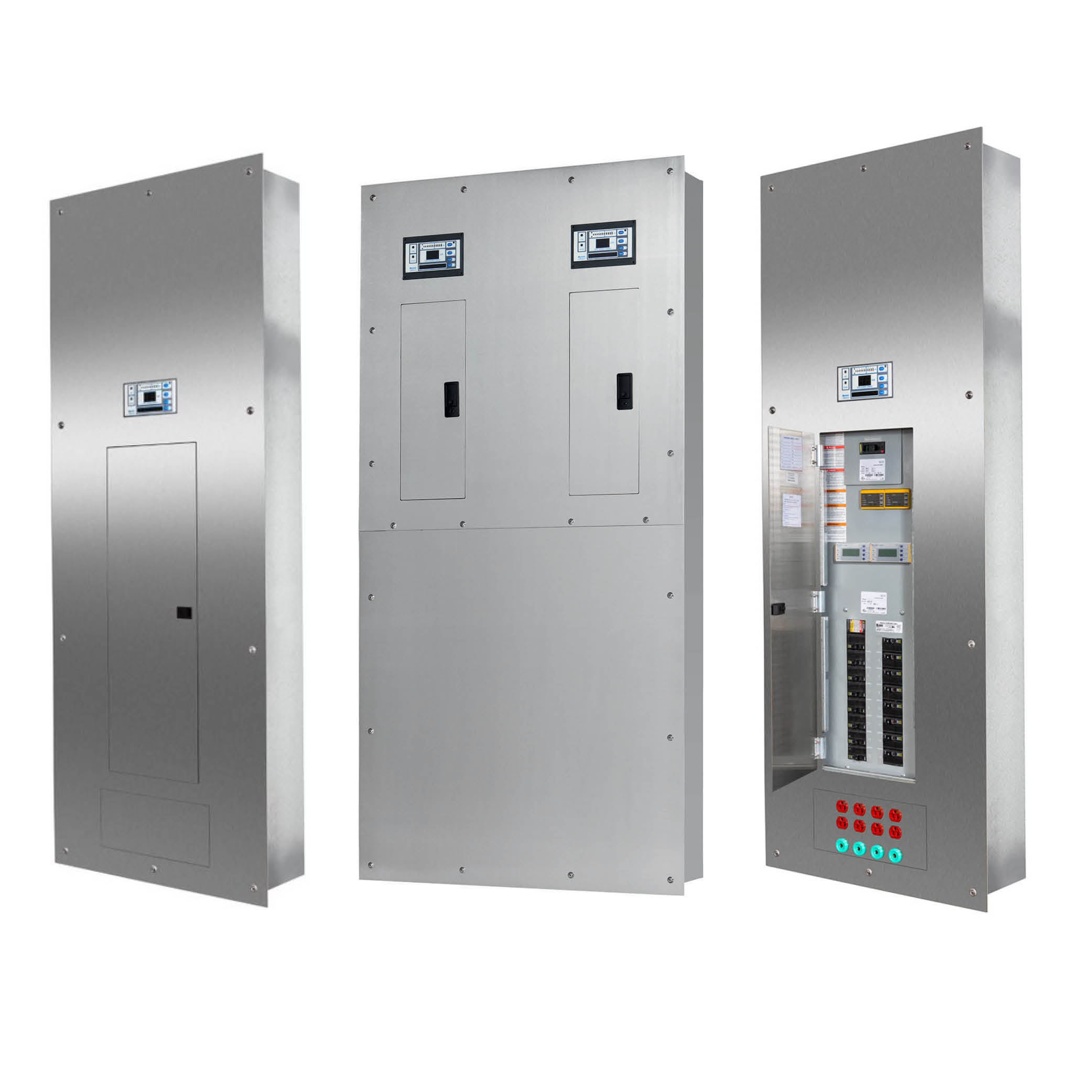Operating Room System Selection Guide for 208V-240V Medical Equipment

According to The Healthcare Facilities Code (NFPA 99), circuits in “Wet Procedure Locations” shall be supplied by either an Isolated Power Systems (IPS) or a Grounded Power system with Class-A GFCIs. This states operating rooms are considered to be a wet procedure location unless a risk assessment conducted by the health care governing body determines otherwise. This means that unless a risk assessment is conducted, then operating rooms are considered to be wet procedure locations by default. In Operating Rooms (ORs) and other critical care spaces, Isolated power is typically chosen over GFCIs as the IPS allows for a continuity of power during an initial ground-fault. When designing such spaces, it is important not to overlook power requirements for specialty medical equipment (most commonly surgical lasers) operating at voltages other than 120V.
The National Electric Code (NEC) only permits an Isolated power system to supply circuits in multiple ORs if 1) the secondary voltage is 150V or greater and 2) the receptacle mating plugs are not interchangeable with the other local Isolated Power System (typically 120V system). This article will discuss the most typical arrangements for Isolated Power Systems for such specialty equipment needs.
Modular Control Isolated Power Panel (MIC)
Commonly, a Modular Control Isolation (MIC) Power Panel is chosen to fulfill the user’s 208V to 240V requirements. The MIC panel is unique in that in addition to the protective components contained in a standard IPS it also has integrated programmable logic which works in unison with associated Laser/X-Ray Receptacle Modules (XRM) located in the individual rooms being served by the IPS. The Laser/X-Ray Receptacle Module’s and integrated remote indicator’s (for the panel’s Line Isolation Monitor) audible and visual alarms are only energized when equipment is plugged into the XRM’s outlet. The MIC also has contacts to activate external relays to energize Laser or Room “In-Use” signage typically located outside the entry of the room. Since only utilized circuits are energized the total connected system impedance is limited to only the circuits that are energized thus a higher system impedance is achieved. (Contact Bender for additional information and methods to assist in meeting minimum impedance requirements).
Unlike most typical Isolated Power Panels, a Modular Control Isolation Power Panel is often installed in a corridor centrally located from the rooms being supplied. Since the MIC requires Laser/X-Ray Receptacle Modules to function it is not suitable for applications in which the receptacles to be energized are installed in the surgical booms.
Modular Standard Isolated Power Panel (MIP/MIE)
Modular Standard Isolated Power Panels have the capability of providing power for a single-voltage system. This panel is similar to the MIC panel; however, it does not contain control components to limit and lock out circuits. If a Modular Standard Isolated Power Panel is used to feed multiple rooms, it is common that a Ground-Fault Location Module (EDS) be utilized. Upon a resistive ground-fault, the Ground-Fault Location Module will inform personnel exactly which circuit the fault has occurred. Without this module, each circuit would need to be analyzed individually to discover where the fault has occurred. Contrary, to the Modular Control Isolated Power a specific XRM is not required for this panel to function properly, thus receptacles located in surgical booms can be easily connected. However, the remote LIM alarm will activate in every room with a circuit served by the panel regardless of whether or not the system is being utilized in the specific location.
Modular Dual Voltage Isolated Power Panel (MID)
Modular Dual Voltage Isolated Power Panels are advantageous as they only require a single feeder to be utilized while providing power for both 120V circuits and 208V or 240V circuits simultaneously. The MID incorporates a dual winding output transformer and the panel is capable of have a max of (16) circuits (typically 20A for standard loads) for the 120V system and up to four circuits (typically 30A, 50A or 60A for laser/x-ray loads) for the 208V or 240V system. The transformer kVA capacity is split between the two different voltages, which is determined by the projects load requirements (total rating of 25kVA with one output 10kVA at 120V and the other 15kVA at 208V is most common).
Modular Dual Voltage Isolated Power Panels are most frequently sought after for new construction projects which will always require power to a laser/x-ray receptacle. It is one of the most common Isolation Panels utilized in the industry today due to its versatility to provide two different voltages from a single Isolation Transformer. Although it is permitted for the 208V or 240V output to supply multiple rooms, care must be taken during the design to understand that the remote LIM alarms will activate in every room with a circuit served by the 208V or 240V output, regardless of whether or not the circuit is being utilized in the specific location. Due to the physical depth of this panel it is often positioned in the corner of the operating room.
Modular Duplex (Dual System) Isolated Power Panel (MIX)
A Modular Duplex Isolated Power Panel contains two Modular Single Standard Isolated Power Systems in the same enclosure, which are separated by a physical barrier. This is a space-saving alternative to a MID panel and requires two incoming feeders (one for each transformer) and provides a secondary voltage per transformer. Since there is no circuit lock-out feature available for this style panel (as provided in the Modular Control Isolated Power Panels) similar limitations exist as the MIP/MIE. Additionally, the maximum rating available for the Modular Duplex Isolated Power Panel is 10kVA per transformer (thus 20kVA total).
Modular Panels Comparison Table for equipment with 208V and 240V requirements
| Panel Style | Bender Model Number |
Max Enclosure Size (H"xW"xD") |
Pros | Cons |
|---|---|---|---|---|
| Modular Control Isolated Power Panel | MIC | 72”x30”x14” | • Most cost effective when supplying more than 2 rooms • Restricts alarms and power to rooms that are in use only • Can integrate control for Laser “In-Use” signage |
• Receptacles may be locked out for use depending on system configuration • Requires manufacturer’s Laser/ X-Ray Receptacle Modules • Depth of enclosure |
| Modular Standard Isolated Power Panel | MIP MIE |
66”x24”x8” 72”x30”x14” |
• Power always available • Smallest physical footprint for requirements 10kVA or less • Works with receptacles integrated in Booms • Ground Fault Location accessory available |
• Potential for alarms to occur in all (including unused) rooms if feeding multiple rooms • No integration of control for Laser “In-Use” signage • Potential for low system impedance when supplying power to more than 2 rooms |
| Modular Dual Voltage Isolated Power Panel | MID | 72”x30”x14” | • Power always available • Only requires one feeder for two voltage outputs • Provides 120V and 208V or 240V simultaneously • Ground Fault Location accessory available • Available up to total rating of 25kVA |
• Depth of enclosure • Max of four circuits offered for 208V-240V side of Isolation Transformer • No Lock-out feature - Potential for alarms in unused rooms if feeding multiple rooms • No integration of control for Laser “In-Use” signage |
| Modular Dual System Isolated Power Panel | MIX | 80”x36”x8” | • Power always available • Efficient Footprint - enclosure houses both 120V and 208 or 240V systems • Ground Fault Location accessory available |
• Requires one feeder per system • Max 10KVA per system (20 kVA |
For more information about this application or to learn more about Bender technology related to your specific application, contact our team of experts.
This article is for informational purposes only. Bender provides the information "as is" without warranty and is not responsible for its accuracy or reliability. No warranties are given regarding its suitability for any specific circumstances.

.jpg)


-1.jpg?width=352&name=Blank%20300%20x%20175%20(3)-1.jpg)